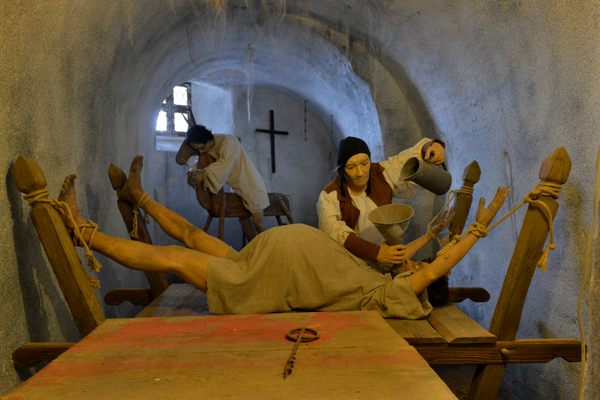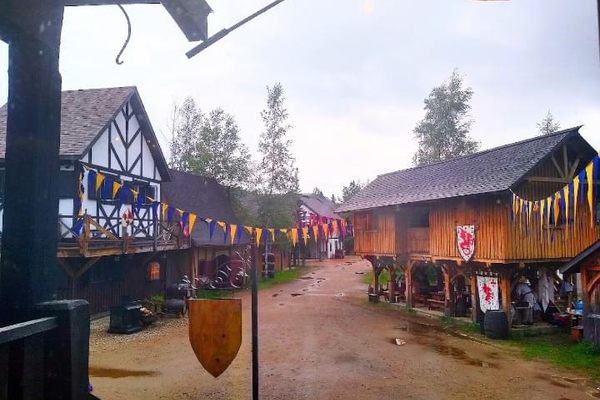A 30-Year Career Writing and Directing for Medieval Times
The family dinner theater’s creative director on how he keeps things fresh, and why it took so long to install a woman on the throne.

In 1983, the first Medieval Times location opened in Kissimmee, Florida. Leigh Cordner, the dinner theater franchise’s director of show, joined the company 30 years ago at that original location, and has since risen to be the creative brains for all nine Medieval Times shows across the U.S. and Canada.
Working with horse trainers, stunt coordinators, musicians, and fictional knights and royals, Cordner has guided the show’s narrative across multiple iterations of the performance. It hasn’t always been easy.
Cordner has had to work to keep a live show featuring sword-fighting, jousting, and feudal intrigue both kid-friendly and consistent across multiple locations. Every change to a scene sends ripples through the entire production. In late 2017, Cordner and company introduced one of the biggest changes in the show’s history, replacing their long-standing king character with a queen.

While the new queen is still in the process of taking her throne, and in advance of a Reddit AMA we’re hosting with Cordner on Monday Feb. 26 at 12 p.m. EST, Atlas Obscura spoke with him about the challenges of installing a female monarch, how he tries to tell a story through action, and why we won’t see dragons at Medieval Times any time soon.
What do you want the feel of a Medieval Times show to be?
It has to be family-friendly, in so much as we’re killing off four or five guys every night. It’s a family destination. The idea is to weave the story through the action. It would be difficult to have an hour and forty-five minutes of non-stop action. You try to make the characters a little multidimensional along the way.
How do you bring these characters to life?
The audience is divided up into six sections each night, so that relationship [with the knights] has already established itself. Whether we had the king before, or the queen, we make sure the audience understands that all the knights that they’re cheering for are in service to the monarch.

What are some of the previous changes you’ve introduced to the story?
We came out of the gate with the first show I wrote. We had an after-the-battle scene all in torchlight, and the guys all in distressed costumes, as a prequel to the show. Then in the next show, we had a flashback scene that we had never done before that took place in the arena, but it was a scene previous to the action in the show. We also started micing some of the knights, which we had never done before, and assigning them speaking roles. That turned into, in the last three shows, the knight wearing the mic, who was subsequently in one of the final combats, was probably going to be carrying one quarter of the dialogue.
After something like 20 years of writing the show on my own, or close to it, I felt like we had probably run all the possibilities. It started seeming repetitive. The king this, the princess that, the king this, the princess that…We were really looking for a way to change the model. And we have to be careful, because people come to see the horses, they come to see the falcon, they come to see the games, they come to see the jousting, so when you look at it, you’re really only talking about 30 percent of the show you can play with.
What kinds of things do people often request to be added to the show?
We have people asking us why we don’t have a dragon, why we don’t use archers. I mean, it’s a 360-degree theater, which way would you like us to shoot the arrows? We had pyro for years, but we took it out. Indoor pyro is expensive and unsafe. A lot of people want us to use fake blood. But we’ve got kids there, and they’re eating dinner. You don’t want to spatter blood all over the front row.
We do take pride that there’s nothing fake about the show. Everybody you see talking is talking. The weapons are real, the combat is real. The stunts on the horses are real. We don’t use anyone in a mask, we don’t use pre-recorded stuff. No video, no lasers. What you see is all real. It’s live.
What are some things that, in a perfect world, you’d like to see added to the show?
We’ve danced around with acrobatics and aerial [performances] over the years. But with the limitations of the ceilings [it’s tough]. Like in California, where they did 81 shows in July, I don’t know how many specialist people I would need to staff that. That was something we experimented with once or twice and then realized it probably wasn’t going to happen.
Then recently we were looking at the floor mapping [projections] that you see the NHL and the NBA doing. The problem is that arenas have a 60-80 foot ceiling height to throw the projection, but ours is only like 25 feet, so it would require a ton of projectors. And then the surface of the arena is only gonna be pristine when the show starts. Once the horses start running around out there, you have this mottled surface that’s not going to be good for projection mapping.
We are upgrading the lights across the country. We’re going all LED.

How did the introduction of the queen occur? How do you think it will change the show?
We wanted to change it up, which is how we came upon the idea of the queen.
It’s really difficult. You’ve got this [show] model that’s 33 years old last year, and you start messing with main characters. Once or twice we’d discussed a plot where the king dies in the first scene, or the show opens with a funeral for the king, but my argument was, ‘it wouldn’t be Medieval Times without The King.’ You go to a castle, you expect to see a king.
That was probably me with blinders on, because why wouldn’t you see a queen?
It was a big thing for us to approach it. We were trying to answer the comments from people who said they’d like to see more females with a higher role in the show, which I felt [the princess had fulfilled]. A fully realized character, a third of the dialogue, the plot revolved around her in several shows. I’d started writing a show with two princesses and we were going to give them the majority of the dialogue, and there was going to be conflict between them. Somewhere along the way it just became unmanageable as far as staffing and training went. It was the president of the company that said to me in a meeting, ‘what about a queen?’ And I said, ‘we can do that.’
Does it surprise you that you hadn’t seized on the idea of installing a queen previously?
I don’t know if the word queen ever came up. I think I was a little resistant to losing the king. It seemed to me that the whole thing would be headless.
It just seemed like so much. Like if McDonald’s stopped offering the Big Mac, y’know? It just seemed like so much change, it was hard to get my head around until I actually sat down to start writing dialogue. When I started to give her a voice, I thought, ‘Oh, this is going to be fun because after all these years of writing this one character’s voice, I’m going to get to write a different character from a whole different perspective and a whole different approach.’

In terms of the writing, what are the differences between the king and the queen?
It was a tightrope at first. My first few attempts were probably overkill with her justifying herself as queen. Luckily a few women who read the script pointed it out to me. They said, ‘she’s spending too much time talking about why she’s the queen. She’s just the queen. The king never spent any time in the show justifying why he was the king.’ I didn’t realize I was doing that, but I see it now.
It was easier to just let conflict develop around her and let her position and her strength solve the conflict. So you see the strength in her without her being involved in the squabbling all the time.
Have you looked at any other bigger female roles in the acts? Female knights?
We’re not there yet. That’s a logistics, staffing, training thing. We have female horse trainers, we have female falconers. The transition to queen means that this woman on stage answers to no one. She’s all-powerful. In the previous two incarnations of the show, [the princess] was fully one-third of the cast, but she was always subservient to the father figure. So the real change here is that we’re putting the queen on our throne for the first time.
Where would you like to see the queen’s story go?
We’re in the middle of the rollout now. We’re only going to be installing the fourth one next month in California. So for the next six-to-ten months, our attention is fully on getting these things rolled out and then polishing it up and maintaining it for the next three-to-four years.
What keeps you there? What is the spirit of Medieval Times that keeps it going?
It’s a family-run company. When I started with this company, it was much smaller. There was just one location in Florida, and one location in California. But as big as it’s gotten, it still feels a little bit like a family company. A lot of the employees have been there 20-25 years, a few of us have been there for over 30 years. I think you get invested in the company’s success. You want the product to be better.
We do change the product every four or five years, so you don’t feel like you’re falling into a rut. I probably would have walked away at some point without that constant change. When I’m not writing a show, it’s my job to fly to all nine cities and watch shows, and give them notes. It’s a live thing. It never stops moving. You’ll never write the last note on a show.
I think that’s why our customers come back too. They enjoy the basic product, but I think they enjoy seeing what we can do with the basic product too.
How do you sum up what Medieval Times offers?
We have the standard line, “Heartstopping Action!” But I think there seems to be an ongoing and sometimes even growing interest in this period. There’s shows about the monarchy in England, the Knights Templar, The Da Vinci Code, Game of Thrones, A Knight’s Tale. Every few years it gets reinvented, and it never quite goes away. If you’re looking for a 21st-century touchstone to any of that, our show’s really the only place you can go. There isn’t anywhere else you can go to see sword-fighting.
This interview has been edited and condensed.













Follow us on Twitter to get the latest on the world's hidden wonders.
Like us on Facebook to get the latest on the world's hidden wonders.
Follow us on Twitter Like us on Facebook